
 |
|
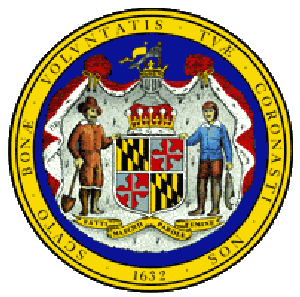













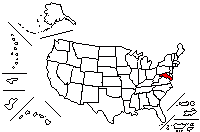
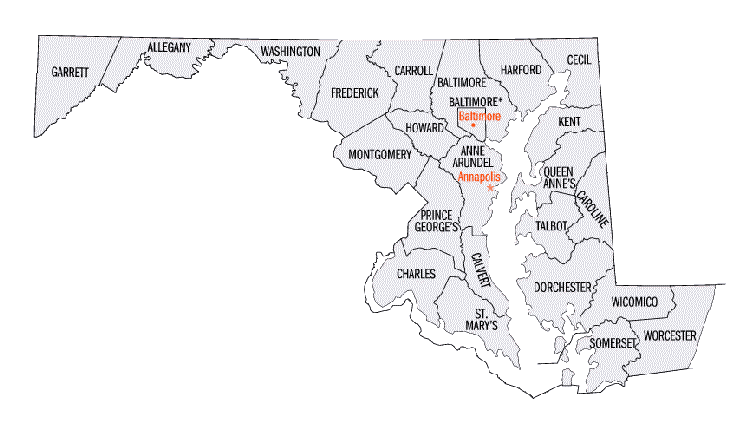

Maryland My Maryland
Written by
James Ryder Randall
The despot's heel is on thy shore,
Maryland, My Maryland!
His torch is at thy temple door,
Maryland, My Maryland!
Avenge the patriotic gore
That flecked the streets of Baltimore,
And be the battle queen of yore,
Maryland! My Maryland!
Hark to an
exiled son's appeal,
Maryland, My Maryland!
My Mother State!to thee I kneel,
Maryland, My Maryland!
For life and death, for woe and weal,
Thy peerless chivalry reveal,
And gird they beauteous limbs with steel,
Maryland! My Maryland!
Thou wilt not cower in the dust,
Maryland, My Maryland!
Thy beaming sword shall never rust,
Maryland, My Maryland!
Remember Carroll's sacred trust,
Remember Howard's warlike thrust,-
And all they slumberers with the just,
Maryland! My Maryland!
Come! 'tis the red dawn of the day,
Maryland, My Maryland!
Come with thy panoplied array,
Maryland, My Maryland!
With Ringgold's spirit for the fray,
With Watson's blood at Monterey,
With fearless Lowe and dashing May,
Maryland! My Maryland!
Come! for thy shield is bright and strong,
Maryland, My Maryland!
Come! for thy dalliance does thee wrong,
Maryland, My Maryland!
Come! to thine own heroic throng,
Stalking with Liberty along,
And cgive a new Key to thy song,
Maryland! My Maryland!
Dear Mother! burst the tyrant's chain,
Maryland, My Maryland!
Virginia should not call in vain!
Maryland, My Maryland!
She meets her sisters on the plain-
"Sic semper!" 'tis the
proud refrain
That baffles minions back amain,
Maryland! My Maryland!
I see the blush upon thy cheek,
Maryland, My Maryland!
For thou wast ever bravely meek,
Maryland, My Maryland!
But lo! There surges forth a shriek
From hill to hill, from creek to creek-
Potomac calls to Chesapeake,
Maryland! My Maryland!
Thou wilt not yield the vandal toll,
Maryland, My Maryland!
Thou wilt not crook to his control,
Maryland, My Maryland!
Better the fire upon thee roll,
Better the blade, the shot, the bowl,
Than crucifixion of the soul,
Maryland! My Maryland!
I hear the distant thunder-hum,
Maryland, My Maryland!
The Old Line's bugle, fife, and drum,
Maryland, My Maryland!
She is not dead, nor deaf, nor dumb-
Huzza! she spurns the Northern scum!
She breathes! she burns! she'll come! she'll come!
Maryland! My Maryland!

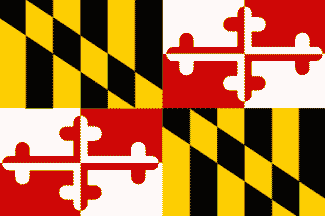
Flag:
The Maryland flag contains the family crest of the Calvert and Crossland families.
Maryland was founded as an English colony in 1634 by Cecil Calvert, the second Lord Baltimore.
The black and Gold designs belong to the Calvert family. The red and white design belongs to
the Crossland family. Flag adopted 1904.
Calvert was the family name of the Lords Baltimore who founded Maryland,
and their colors of gold and black appear in the first and fourth quarters
of the flag. Crossland was the family of the mother of George Calvert,
first Lord Baltimore. The red and white Crossland colors, with a cross bottony,
appear in the second and third quarters. This flag first was flown October 11,
1880, in Baltimore at a parade marking the 150th anniversary of the founding of Baltimore.
It also was flown October 25, 1888, at Gettysburg Battlefield for ceremonies dedicating
monuments to Maryland regiments of the Army of the Potomac.
Bandera:
La bandera de Maryland contiene la cresta de las Familias Calvert y Crossland.
Maryland fué fundado como una colonia Inglesa en el 1634 por Cecil Calvert, el segundo
Lord de Baltimore. Los diseños negros y oro pertenecen a la familia Calvert. El rojo y blanco
pertenecen a la familia Crossland. La bandera fué adoptada en el 1904.
Calvert fué el nombre de la famila de los Lores de Baltimore quienes fundaron a Maryland,
y sus colores, oro y negro aparecen en el primer y cuerto cuadrante de la bandera. Crossland
fué la familia de la madre de George Calvert, primer Lord de Baltimore. El rojo y el blanco que
representa a los Crossland, con una cruz, aparecen en el segundo y tercer cuadrante. Esta bandera
fué enarbolada por primera vez el 11 de octubre de 1880 en Baltimore en una parada donde
se celebraba el 150 aniversario de la fundación de Baltimore. También fué enarbolada el 25 de octubre
de 1888 en el campo de batalla de Gettysburg para las ceremonias dedicada a los monumentos
del regimiento del ejercito del Potomac.

Maryland
Maryland (se pronuncia Mé-ri-lannd en inglés y español)
Capital City: Annapolis
Admission to Statehood: April 28, 1788
National: Marylanders
Border States: Delaware - Pennsylvania - Virginia - West Virginia
Motto: Fatti Maschii Parole Femine; Scuto Bonae Voluntatis Tuae Coronasti Nos
(“Manly Deeds, Womanly Words”) and “With favor Wilt Thou Compass Us as with a Shield”
The first motto is the motto of the Calvert family, whose history is closely tied to the state.
The second motto is derived directly from the twelfth verse of the Fifth Psalm.
Nickname: Old Line State
Origin of state's name: Named by England. Named to honor Henrietta Maria,
wife of England's King Charles I
Ciudad Capital: Annapolis (An-ná-po-lis en inglés y español)
Admición como estado: 28 de abril de 1788
Gentilicio: Marylandianos (Mé-ri-lan-dia-nos)
Estados limítrofes: Delaware - Pennsylvania - Virginia - West Virginia
Lema: Fatti Maschii Parole Femine; Scuto Bonae Voluntatis Tuae Coronasti Nos -
( hechos de hombres, palabras femeninas") y " con favor Vos nos rodearás como un escudo".
El primer lema es el lema de la familia Calvert, cuya historia está atada al estado.
El segundo lema es una derivación directa del verso 20 del quinto salmo.
Cognómento: Estado de la vieja Línea
Origen del Nombre: Nombrado así por los ingleses en honor a Henrietta María,
esposa del rey de Inglaterra Carlos I.

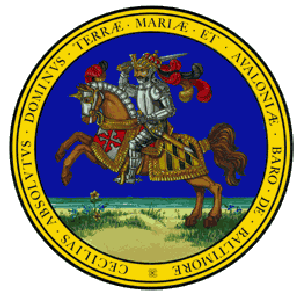

The Seal:
The Great Seal of Maryland is used by the Governor and the Secretary of State to
authenticate Acts of the General Assembly and for other official purposes. The
Secretary of State is the official custodian of the Great Seal, and provides guidance
on its use.
Only the reverse of the Great Seal has ever been cut. Since 1969, however, the obverse,
has been considered part of the Seal and often adorns public buildings.
The reverse of the Great Seal of Maryland consists of an escutcheon,
or shield, bearing the Calvert and Crossland arms quartered. Above is
an earl's coronet and a full-faced helmet. The escutcheon is supported on
one side by a farmer and on the other by a fisherman. It symbolizes Lord
Baltimore's two estates: Maryland, and Avalon in Newfoundland.
The obverse of the Great Seal of Maryland shows Lord Baltimore as a knight
in full armor mounted on a charger. The inscription translated is "Cecilius,
Absolute Lord of Maryland and Avalon, Baron of Baltimore" .
The first Great Seal was brought over during the early days of the Maryland colony,
but was stolen by Richard Ingle during his rebellion of 1645. Cecilius Calvert,
2nd Lord Baltimore, sent a similar seal from England in 1648 for the use of the
Maryland Chancellor. Except for the period of crown rule (1692-1715), that Great
Seal remained in use until the end of the 18th century, the Maryland Council
having authorized continued use of the provincial seal on March 31, 1777.
A new seal with republican imagery was adopted by the Governor and Council
on February 5, 1794. Designed by Charles Willson Peale, the Maryland Seal
of 1794 remained in use until 1817. In that year, the General Assembly adopted
a single-sided Great Seal bearing an eagle holding a shield. Another seal
authorized in 1854 depicted an eagle and a version of the Calvert arms.
Maryland readopted the reverse of the original Calvert seal in 1874.
This new seal corrected the imagery of the Calvert arms in the seal of 1854.
It is the seal in use today.
El Sello
El Gran Sello de Maryland es utilizado por el Gobernador y el Secretario de Estado para propósitos oficiales.
Su custodio es el Secretario de Estado y provee las guias oficiales para su uso.
Solo el reverso del sello siempre a sido excluido. Desde el 1969, sin embardo, el anverso,
a sido considerado parte del sello y adorna los edificios públicos.
El reverso del sello de Maryland consiste de un emblema o escudo, portanto los emblemas de
Calvert y Crossland. Encima está la corona del conde y un casco cubre rostro. Es escudo está
sujetado en uno de sus lados por un campesino y en el otro por un pescador. Esto simbolia los
dos estados de Lord Baltimore: Maryland y Avalon en
Terranova. En anverso del Gran Sello presenta a Lord Baltimore como un Caballero con toda su
armadura cabalgando a la batalla. La traducción de la inscripción dice: "Cecilius, Señor Absoluto
de Maryland y Avalon, Barón de Baltimore".
El primer Gran Sello fué traido durante los primeros días de Marylando como colonia, pero
fué robado por Richard Ingle durante su revelión en el 1645. Cecilius Calvert, 2do Lord de Baltimore,
envió un sello similar desde Inglaterra en el 1648 para ser usado en la Cancillería de Maryland.
Con excepción al período del dominio de la corona (1692-1715), Ese Gran Sello permaneció en uso
hasta el final del siglo 18, la cancillería de Maryland autorizó el continuar utilizando el
sello provincial el 31 de marzo de 1777. Un nuevo sello una imagen republicana fué adoptado por el
bovernador y consul el 5 de febrero de 1794. Diseñado por Charles Willson Peale, ese sello
permaneció en uso hasta el 1817. En ese año, la Asamblea General adoptó un Gran Sello de un
solo lado con un águila sujetando un escudo. Otro Sello autorizado en el 1854 representó un águila
y una versión del escudo de Calvert. Maryland readoptó el reverso del sello original en el
1874. Este nuevo sello corrijió la imagen del escudo de Calvert en el sello de 1854.
Este es el sello que se sigue utilizando hoy en día.

Located in the extreme northeastern section of the United States,
Maine is bordered by the Canadian provinces of Quebec on the
northwest and New Brunswick on the north and east, by New Hampshire
on the west, and by the Atlantic Ocean on the southeast and south.
History
Maryland, one of the Middle Atlantic states of the United States.
One of the 13 original states, Maryland was named for Queen Henrietta
Maria, wife of Charles I of England. The area was first colonized
in 1634 and played a major role in the nation's early history and
struggle for independence. During the Civil War, Maryland was divided
on the issue of secession and was placed under military rule to
keep it within the Union and protect the nation's capital. The s
tate capital is Annapolis, which lies within the metropolitan area
of Baltimore, Maryland's largest city.
Giovanni da Verrazano is thought to have visited the Atlantic coast
near Chincoteague Bay in 1524. In 1526, Spanish explorers sailed
into Chesapeake Bay and called it Santa Maria, a name that appears
on a 1556 map. In 1608, Captain John Smith of Virginia became the
first authenticated European visitor. In late 1631, William Clairborne
established a fur-trading post, which is regarded as the first
permanent European settlement, on Kent Island (opposite Annapolis).
At the time of early European settlement, the principal Indian groups
were three Algonquian tribes--the Piscataway on the Western Shore,
who left the area in 1697; and the Nanticoke and Pocomoke-Assateague
on the Eastern Shore, who migrated westward in the 1740s.
The Susquehannock also inhabited the area, but in 1675 they were
carried into captivity by the Iroquois Nations.
In 1632, King Charles I of England granted George Calvert, (The Calvert
family was principally responsible for the planning and
settlement of the province of Maryland)
1st Baron Baltimore
settlement rights to lands between the 40th parallel and
the south bank of the Potomac. Calvert died before the papers
were complete, and the charter passed to his son Cecilius (Cecil)
Calvert, 2d Baron Baltimore. In November 1633, 200 colonists set
sail from England in the Ark and the Dove, which landed on Mar. 24,
1634, at Saint Clement (now Blakistone) Island at the mouth of the
Potomac. They purchased the Indian village of Yaocomico, which they
renamed St. Mary's (now St. Mary's City) and used for 60 years as the
capital and center of the colony. Lord Baltimore, a Roman Catholic,
sought religious freedom for the colony, and in 1649 the Colonial
Assembly passed the Act Concerning Religion, the first statute in
the colonies to provide freedom of worship for all Christians.
From 1692 to 1715, Maryland was a crown colony,
ruled by royal governors. During this period the Church
of England was the official religion, and in 1694
the capital moved to Annapolis. The Baltimores regained
control in 1715. At first the colony had a diversified
agriculture, but by the end of the 17th century tobacco was
the staple crop.
In the Revolutionary period, Maryland was one of the first
colonies to repudiate the Stamp Act (1765). Early in the colonial
resistance to British rule, Marylanders had their own "tea party,"
in 1774 in Chestertown when the tea-carrying ship Peggy Stewart was
burned in Annapolis harbor. On July 3, 1776, the state disavowed its
allegiance to the king, and 4 months later was the first of the former
colonies to adopt a state constitution. Marylanders were active in
both Continental Congresses and in the signing of the Declaration of
Independence. During the Revolutionary War, Maryland troops
distinguished themselves in battles outside the state, but no
fighting took place in the state. In 1788, Maryland became the
7th state to ratify the U.S. Constitution, and in 1791 it ceded
to the nation 174 sq./km. (67 sq./mi. ) along the Potomac for
construction of the District of Columbia.
Maryland's early years of statehood were spent in developing
the state's resources. Shipping and trade expanded, and families
abandoning the worn-out tobacco farms of the Eastern Shore and
southern Maryland migrated westward into the Piedmont. Baltimore,
incorporated in 1797, grew rapidly as a port, shipbuilding, and
industrial center, attaining a population of 26,500 (more than Boston)
in 1800 and 169,000 in 1850. New transportation facilities integrated
the growing trade of lands west of the Appalachians into the region.
Among the more important routes were the National Road (1818);
the Chesapeake and Delaware Canal (1829) across the Delmarva Peninsula;
the Chesapeake and Ohio Canal along the Potomac River to Cumberland
and the coalfields of western Maryland; and the Baltimore and Ohio
Railroad, the first U.S. passenger railroad, begun in 1828.
At the outbreak of the Civil War, Maryland had almost equal numbers
of slaves and free blacks, and the state was sharply divided in its
sympathies to North and South. However, when neighboring Virginia
seceded, Maryland's presence within the Union became vital to the
defense of Washington, D.C., and President Lincoln was forced to
prevent secession by imposing military rule. Fierce battles fought
on Maryland soil included the battles of South Mountain and Antietam
(both in 1862) and Monocacy (1864).
LMaryland, uno de los estados del atlántico medio de los Estados Unidos.
Uno de los 13 estados originales, Maryland fue nombrado por la reina
Henrietta Maria, esposa de Carlos I de Inglaterra. El área primero
fue colonizada en 1634 y jugó un papel importante en la historia
temprana de la nación y la lucha para la independencia. Durante la
guerra civil, Maryland estaba dividido con el asunto de la secession y
fué colocado bajo regla militar para guardarla dentro de la unión y para
proteger el capital de la nación. El capital del estado es
Annapolis, que está dentro del área metropolitana la ciudad más
grande de Maryland, Baltimore.
Se cree que Giovanni da Verrazano pudo haber visitado la costa
atlántica cerca de la bahía de Chincoteague en 1524. En 1526, los
exploradores españoles navegaron en bahía del chesapeake y la
llamaron Santa María, un nombre que aparece en un mapa 1556. En
1608, el capitán John Smith de Virginia se convirtión
en el primero visitante europeo
autentico. A finales de 1631, William Clairborne
estableció un puesto para intercambio de pieles,
que se vé como el primer
establecimiento europeo permanente, en la isla de Kent (frente a
Annapolis). Al principio de esos establecimientos, los
grupos indios principales eran tres tribus de Algonquian -- el
Piscataway en la orilla occidental, quienes dejaron el área en
1697; y el Nanticoke y el Pocomoke-Assateague en la orilla del este,
que emigró hacia el oeste en el 1740. El Susquehannock también
habitó el área, pero en 1675 fueron llevados en cautiverio por la
nación Iroquois.
En 1632, el rey Carlo I de Inglaterra concedió a George Calvert, (la
familia Calvert fueron los principales responsable de la planificación y
el establecimiento de la provincia de Maryland) 1r barón Baltimore,
el derecho a las tierras entre el 40.o paralelo y el
banco del sur del Potomac. Calvert murió antes de que los papeles
fueran completados, y la carta pasó a su hijo Cecilius (Cecil) Calvert,
2do barón de Baltimore. En noviembre 1633, 200 colonos salieron
de Inglaterra en la embarcación El Arca y la Paloma,
que llegaron el 24 de marzo de
1634, en la isla San Clemente (ahora Blakistone) en la boca del
Potomac. Compraron la aldea india de Yaocomico, que renombraron St.
Mary (ahora ciudad St. Mary) y utilizado por 60 años como el
capital y el centro de la colonia. Señor Baltimore, un Católico Romano,
buscó la libertad religiosa para la colonia
y en 1649 la asamblea
colonial pasó el acta referente a la religión, el primer estatuto en
las colonias para proporcionar la libertad de la adoración para todos
los cristianos.
A partir del 1692 a 1715, Maryland eran una colonia de la corona,
gobernada por los gobernadores reales. Durante este período la
iglesia de Inglaterra era la religión oficial, y en 1694 el capital
se movió a Annapolis. Los Baltimore recuperaron el control el 1715.
Al
principio la colonia tenía una agricultura diversificada, pero antes
del fin del siglo 17 el tabaco era la cosecha de la principal.
En el período revolucionario, Maryland fué una de las primeras
colonias en repudiar el Stamp Act (1765). A principio de la
resistencia colonial al régimen británico, los Marylandianos tenía sus el
propios " partido del té, " en 1774 en Chestertown cuando la nave
que llevaba té Peggy Stewart fue quemada en el puerto de Annapolis.
El 3 de julio de 1776, el estado rechazó su lealtad al rey, y 4
meses más tarde era la primera de las antiguas colonias en
adoptar una constitución del estado. Los marylandianos fueron activo
en ambos
congresos continentales y en la firma de la declaración de la
independencia. Durante la guerra revolucionaria, las tropas de Maryland
se distinguieron en batallas fuera del estado, pero ninguna batalla
tubo lugar en el estado. En 1788, Maryland se convirtió en el
7mo estado para ratificar la constitución de ESTADOS UNIDOS, y en
1791 cedió a la nación 174 sq./km. (67 sq./mi.) a lo largo del
Potomac para la construcción del districto de Colombia.
Los primeros años de Maryland como estado fueron basados
en desarrollar
los recursos del estado. El exportación y el comercio fueron
ampliados, y las
familias que abandonaban las granjas gastadas del tabaco de la orilla
del este y del Maryland meridional emigraron hacia el oeste en el
Piedmont. Baltimore, incorporada en 1797, creció rápidamente como
puerto, constructora naval, y un centro industrial, logrando una
población de 26.500 (más que Boston) en 1800 y 169.000 de 1850. Las
nuevas instalaciones del transporte integraron el comercio cada vez
mayor de tierras al oeste de los apalaches en la región. Entre las
rutas más importantes estaba el camino nacional (1818); el
chesapeake y el canal de Delaware (1829) a través de la península de
Delmarva; el chesapeake y el canal de Ohio a lo largo del río de
Potomac a Cumberland y las cuencas carboníferas de Maryland
occidental; y el ferrocarril de Baltimore y de Ohio, el primer
ferrocarril de pasajero de ESTADOS UNIDOS, comenzó en 1828. En el
brote de la guerra civil, Maryland tenía números casi iguales de
esclavos y de negros libres, y el estado estuvo dividido fuertemente en
sus simpatías con el norte y el sur. Sin embargo, cuando la
vecina Virginia se separó, la permanencia de Maryland dentro de la unión
llegó a
ser vital a la defensa de Washington,D.C., y un régimen militar impuesto
por el presidente Lincoln para prevenir la separación. Las más feroces batallas
en el suelo de Maryland incluyeron las batallas de
South Mountain and Antietam (ambos en 1862) y Monocacy (1864).
